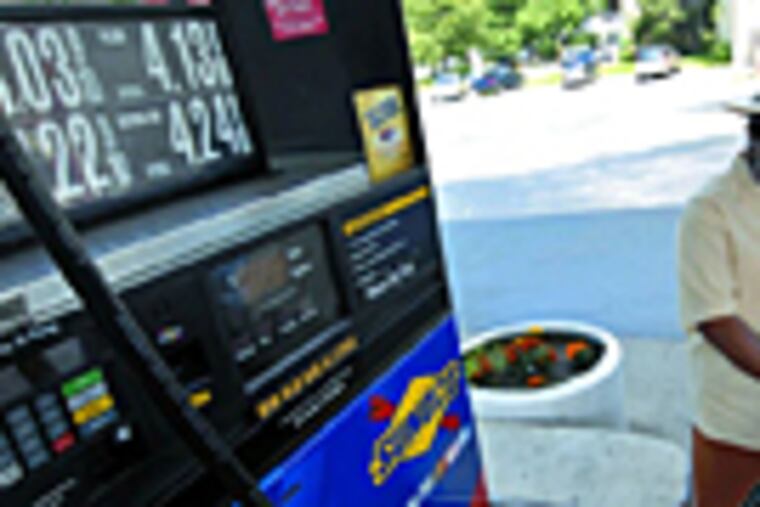Pa. gas tops $4 mark
Average gasoline prices finally nudged across the $4-a-gallon barrier in Southeastern Pennsylvania yesterday, following an unwelcome pattern already set in New England, the West Coast, Hawaii and some other states.

Average gasoline prices finally nudged across the $4-a-gallon barrier in Southeastern Pennsylvania yesterday, following an unwelcome pattern already set in New England, the West Coast, Hawaii and some other states.
The average pump price in the five-county area rose two cents from Thursday to $4.01 a gallon for regular-grade, AAA Mid-Atlantic said. For the area - Philadelphia and its four suburban counties - that marks an increase of 38 cents a gallon in the last month.
In the three suburban counties in South Jersey, the average was $3.84, up a penny.
Now that gasoline is topping $4 a gallon, Mount Airy resident Desmond Ward said he will push to have repair work on his Pontiac Bonneville finished so he can sideline his premium-gasoline-loving Land Rover. The Bonneville takes regular.
"It's tough now," said Ward, who said he has been unable to work at his job delivering bread because of an injury.
Ward was filling up the Land Rover yesterday at a Sunoco station near his home. Regular gas was selling there for $3.999 a gallon. Premium went for $4.179.
The Rover gets 11 to 18 miles per gallon in the city compared with about 19 miles per gallon for the Bonneville, according to Autohopper, a car-sales Web site that includes gas-mileage comparisons.
At a station in Fairmount, Fran Burns put $72 on her credit card to fill up her Mazda CX7 - premium, at $4.119 a gallon.
Though she lives in Philadelphia and could take public transportation, she said she needs her car - which needs premium - for work.
Why not switch to a car that runs on regular? "I can't," she said. "I'm just one year into my lease."
A reflection of soaring prices: The number of motorists in the five Pennsylvania counties of the Philadelphia region calling AAA for assistance because they ran out of gas doubled this month to 162 compared with May last year. And, said AAA Mid-Atlantic spokeswoman Catherine L. Rossi, the tally for this month was only through Wednesday.
Aside from inconvenience, letting a gas tank run to empty means sediment could settle into and damage a car's fuel pump and injector. "You don't want that to happen," Rossi said.
Looking ahead, she forecast continued high pump prices through at least the first half of the summer. That's because it takes four to six weeks for the effect of high crude oil prices to be felt by motorists.
Nationally, yesterday's average for regular rose a penny from Thursday to $3.96 a gallon, and is probably on course to hit $4 next week.
Gas prices already average more than $4 in 12 states and the District of Columbia.
Meanwhile, light, sweet crude oil for July delivery rose 73 cents yesterday to close at $127.35 a barrel on the New York Mercantile Exchange.
The trading reflected an ongoing battle in the oil market between investors who feel prices have risen too far, and those who think global demand and tight supplies justify prices in the $130s - or higher. The record close was on May 21, at $133.17 - though the futures traded above $135 during that day's session.
Additional selling pressure yesterday came from a Commodity Futures Trading Commission investigation into possible price manipulation in oil futures markets. The commission also announced new rules designed to increase transparency of U.S. and international energy futures markets.
If oil prices fall, gas prices eventually will follow, analysts said.
However, another element - the weather - could be a factor this summer.
Meteorologists are predicting a busy hurricane season, and any direct hit on the Gulf of Mexico's extensive oil and gas infrastructure could easily send oil prices rocketing past $150 a barrel.
"If we get anything that disrupts gulf production in a meaningful way . . . I think it could easily push prices to the $150 level," said Brad Samples, an analyst at Summit Energy Services Inc. in Louisville, Ky.
The gulf is home to hundreds of oil and gas drilling platforms and pipelines that are typically shut down when a storm approaches. Hurricanes can damage platforms or scatter pipelines, and that can take months to repair.